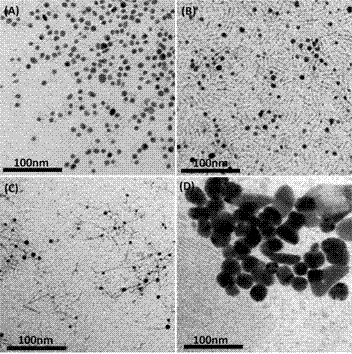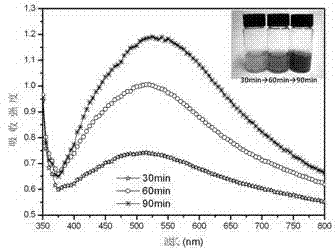Preparation method of surfactant for photo-reduction method of Ag/TiO2 nano heterogenous junction by virtue of induction
A surfactant and heterojunction technology, applied in catalyst activation/preparation, chemical instruments and methods, physical/chemical process catalysts, etc., can solve the problem of reduced contact area, uneven size of nano-noble metal particles, low utilization rate of visible light, etc. problems, to achieve the effect of low cost, simple and easy-to-implement process and high efficiency
- Summary
- Abstract
- Description
- Claims
- Application Information
AI Technical Summary
Problems solved by technology
Method used
Image
Examples
preparation example Construction
[0020] Ag / TiO 2 The steps of the photoreduction surfactant-induced preparation method of the nano-heterojunction are as follows:
[0021] 1) 0.1-1.0g TiO with 0.1-0.5ml of oleic acid, oleylamine or 1-octadecene as surfactant 2 Nanocrystals are dispersed in 50ml chloroform, stirred and mixed evenly to obtain TiO 2 Nanocrystalline dispersion;
[0022] 2) Take 0.2-0.5g of AgNO 3 Dissolve in 10ml ethanol, add TiO 2 Nanocrystalline dispersion, stirred evenly, then transferred to a three-necked flask, degassed with argon for 20-60 minutes, sealed, and carried out photoreduction synthesis with xenon lamp as light source for 30-90 minutes under stirring to obtain Ag / TiO 2 nanoheterojunction.
Embodiment 1
[0025] Rod TiO with oleic acid as surfactant 2 Disperse nanocrystals in 50ml chloroform, stir and mix evenly to obtain uniform and transparent TiO 2 Nanocrystalline dispersion, rod-shaped TiO 2 The addition amount of nanocrystal is 0.8g.
[0026] Take 0.3g of AgNO 3 Dissolved in 10ml ethanol, the resulting solution was mixed with the above TiO 2 The nanocrystal dispersion liquid was mixed, stirred evenly, and then transferred to a three-necked flask, and the system was degassed with argon for 30 minutes. Finally, the mixture was sealed in a flask, and the photoreduction synthesis was carried out for 30 min, 60 min and 90 min under the condition of stirring with a xenon lamp as a light source, thereby preparing three kinds of "matchstick"-like structures (Ag particles / TiO 2 nanorods) Ag / TiO 2 Nano-heterojunction samples.
[0027] The as-synthesized TiO was characterized by TEM (80kV) 2 Nanorods and Ag / TiO 2 Size and morphology of heterojunctions. XRD was used to analyz...
Embodiment 2
[0039] Rod TiO with oleylamine as surfactant 2 Disperse nanocrystals in 50ml chloroform, stir and mix evenly to obtain uniform and transparent TiO 2 Nanocrystalline dispersion, rod-shaped TiO 2 The addition amount of nanocrystal is 0.5g.
[0040] Take 0.2g of AgNO 3 Dissolved in 10ml ethanol, the resulting solution was mixed with the above TiO 2 The nanocrystal dispersion was mixed, stirred evenly, and then transferred to a three-necked flask, and the system was degassed with argon for 60 minutes. Finally, the mixture was sealed in a flask, and the photoreduction synthesis was carried out for 45 minutes with xenon lamp as the light source under the condition of stirring, and finally successfully prepared a compound with excellent photocatalytic performance and a "matchstick" structure similar to Example 1. (Ag particles / TiO 2 nanorods) Ag / TiO 2 nanoheterojunction.
PUM
 Login to View More
Login to View More Abstract
Description
Claims
Application Information
 Login to View More
Login to View More - R&D
- Intellectual Property
- Life Sciences
- Materials
- Tech Scout
- Unparalleled Data Quality
- Higher Quality Content
- 60% Fewer Hallucinations
Browse by: Latest US Patents, China's latest patents, Technical Efficacy Thesaurus, Application Domain, Technology Topic, Popular Technical Reports.
© 2025 PatSnap. All rights reserved.Legal|Privacy policy|Modern Slavery Act Transparency Statement|Sitemap|About US| Contact US: help@patsnap.com



